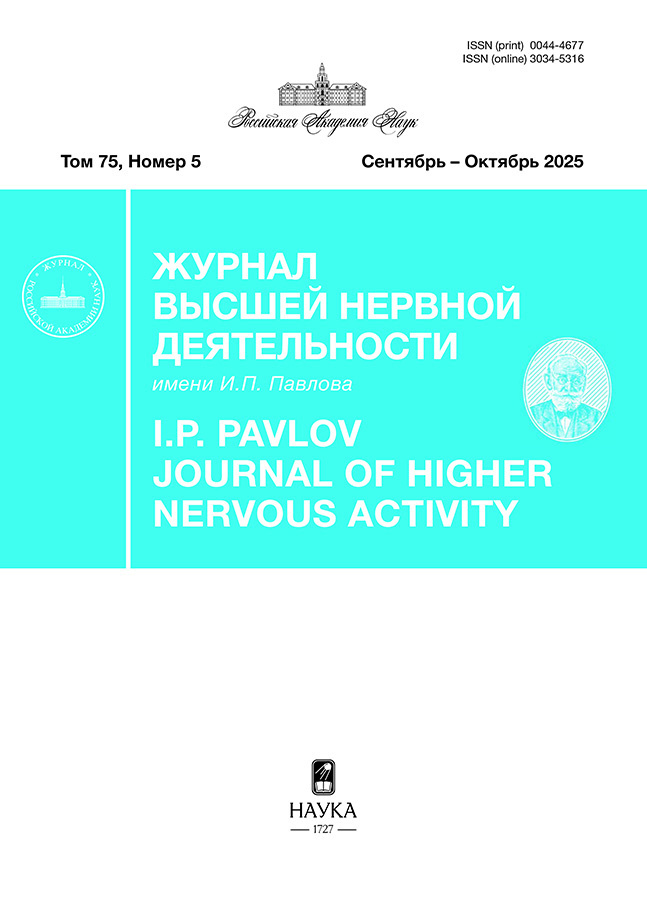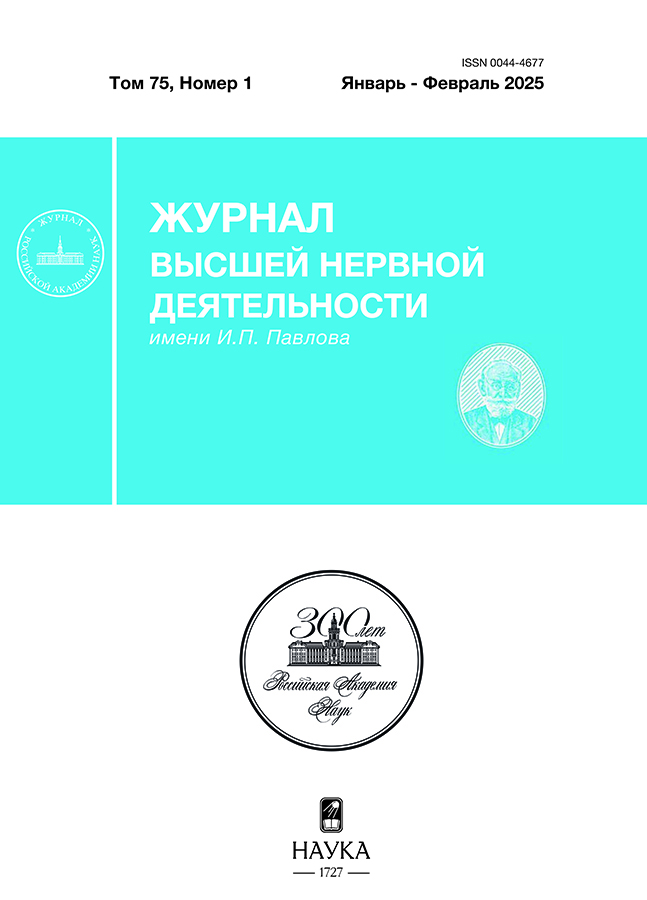Investigation of the possible involvement of the deprivational potentiation mechanisms in memory consolidation during sleep
- Authors: Popov V.A.1, Korshunov V.A.1
-
Affiliations:
- Institute of Higher Nervous Activity and Neurophysiology of the Russian Academy of Sciences
- Issue: Vol 75, No 1 (2025)
- Pages: 117-128
- Section: ФИЗИОЛОГИЧЕСКИЕ МЕХАНИЗМЫ ПОВЕДЕНИЯ ЖИВОТНЫХ: ВОСПРИЯТИЕ ВНЕШНИХ СТИМУЛОВ, ДВИГАТЕЛЬНАЯ АКТИВНОСТЬ, ОБУЧЕНИЕ И ПАМЯТЬ
- URL: https://cardiosomatics.orscience.ru/0044-4677/article/view/682793
- DOI: https://doi.org/10.31857/S0044467725010107
- ID: 682793
Cite item
Abstract
We examine the hypothesis of the possible role of deprivational potentiation in memory consolidation during rest/sleep after one day learning in Morris water maze. We used pharmacologic, genetic and neurophysiologic factors which prevent deprivational potentiation. Seven days after learning we tested memory. Our experiments do not confirm the hypothesis that deprivational potentiation is involved in memory consolidation. Also, we found that Pannexin1 knockout mice can learn both egocentric and allocentric spatial tasks in Morris water maze.
Full Text
About the authors
V. A. Popov
Institute of Higher Nervous Activity and Neurophysiology of the Russian Academy of Sciences
Author for correspondence.
Email: v-lad-i-mir@yandex.ru
Russian Federation, Moscow
V. A. Korshunov
Institute of Higher Nervous Activity and Neurophysiology of the Russian Academy of Sciences
Email: vkorshunov@ihna.ru
Russian Federation, Moscow
References
- Виноградова О.С. Гиппокамп и память. М.: Наука, 1975. 334 c.
- Дорохов В.Б., Кожедуб Р.Г., Арсеньев Г.Н., Кожечкин С.Н., Украинцева Ю.В., Куликов М.А., Манолов А.И., Ковальзон В.М. Влияние депривации сна на консолидацию пространственной памяти крыс после однодневного обучения в водном тесте Морриса. Журн. высш. нервн. деят. им. И.П. Павлова. 2011. 61 (3): 322–331.
- Дорохов В.Б., Пучкова А.Н. Нейротехнологии нефармакологической терапии нарушений сна. Журн. высш. нервн. деят. им. И.П. Павлова. 2022. 72(1): 55–76.
- Зосимовский В.А., Коршунов В.А. Возвращение в гиппокампальную формацию волн возбуждения, выходящих из поля СА1, облегчается после тетанизации коллатералей Шаффера и во время сна. Журн. высш. нервн. деят. им. И.П. Павлова. 2009. 59 (1): 87–97.
- Зосимовский В.А., Коршунов В.А. Волна возбуждения, возвращающаяся в гиппокамп через энторинальную кору, может реактивировать популяции «обученных» нейронов поля СА1 в периоды глубокого сна. Журн. высш. нервн. деят. им. И.П. Павлова. 2010. 60 (5): 568–581.
- Кичигина В.Ф., Шубина Л.В., Попова И.Ю. Роль зубчатой извилины в осуществлении функций гиппокампа: здоровый мозг. Журн. высш. нервн. деят. им. И.П. Павлова. 2022. 72 (3): 317–342.
- Ковальзон В.М. Основы сомнологии: физиология и нейрохимия цикла «бодрствование – сон». М.: БИНОМ. Лаборатория знаний, 2012. 239 с.
- Коршунов В.А. Метод исправления перспективных искажений при видеотрекинге животных в бассейне Морриса. Журн. высш. нервн. деят. им. И.П. Павлова. 2014. 64 (2): 240–245.
- Коршунов В.А. Простые индексы для оценки выполнения задач в бассейне Морриса. 15-й Международный междисциплинарный конгресс “Нейронаука для Медицины и Психологии”. Судак, Крым, Россия, 30 мая – 10 июня 2019 г.с. 237.
- Коршунов В.А., Узаков Ш.С. Дефицит гиппокамп-зависимого обучения не коррелирует с подавлением долговременной посттетанической потенциации при системной блокаде НМДА-рецепторов. Журн. высш. нервн. деят. им. И.П. Павлова. 72 (3): 405–420.
- Попов В.А. Спонтанная потенциация фокальных потенциалов поля СА1 в длительно переживающих гиппокампальных срезах крысы при отсутствии электрической стимуляции. Журн. высш. нерв. деят. им. И.П. Павлова. 1994. 44 (1): 149–158.
- Попов В.А. Пре- и постсинаптический механизмы депривационной потенциации популяционных ответов нейронов поля СА1 гиппокампа крыс. Журн. высш. нерв. деят. им. И.П. Павлова. 2016. 66 (2): 209–219.
- Попов В.А. Участие паннексинов-1 в механизме депривационной потенциации популяционных спайков нейронов поля CA1 гиппокампа крыс. Журн. высш. нерв. деят. им. И.П. Павлова. 2020. 70 (3): 360–374.
- Попов В.А., Маркевич В.А. Развитие медленной потенциации популяционного спайка длительно не стимулируемого входа у крыс в состоянии наркотического сна. Журн. высш. нерв. деят. им. И.П. Павлова. 1999. 49 (4): 689–693.
- Попов В.А., Маркевич В.А. Исследование механизма развития «депривационной» потенциации популяционных ответов нейронов поля СА1 на переживающих срезах гиппокампа. Журн. высш. нервн. деят. им. И.П. Павлова. 2001. 51 (5): 598–603.
- Попов В.А., Маркевич В.А. Ключевая роль кальция в механизме депривационной потенциации популяционных ответов нейронов поля СА1 гиппокампа. Журн. высш. нервн. деят. им. И.П. Павлова. 2014. 64 (1): 54–63.
- Battulin N., Kovalzon V.M., Korablev A., Serova I., Kiryukhina O.O., Pechkova M.G., Bogotskoy K.A., Tarasova O.S., Panchin Y. Pannexin 1 Transgenic Mice: Human Diseases and Sleep-Wake Function Revision. Int. J. Mol. Sci. 2021. 22: 5269 (1–14).
- Bliss T.V.P., Collingridge G.L. A synaptic model of memory: long-term potentiation in the hippocampus. Nature. 1993. 361: 31–39.
- Bliss T.V.P., Lømo T. Long-lasting potentiation of synaptic transmission in the dentate area of the anaesthetized rabbit following stimulation of the ptrforant path. J. Physiol. 1973. 232: 331–356.
- Born J., Rasch B., Gais S. Sleep to Remember. Neurosci. 2006. 12(5): 410–424.
- Born J., Wilhelm I. System consolidation of memory during sleep. Psychol. Res. 2012. 76: 192–203.
- Brodt S., Inostroza M., Niethard N., Born J. Sleep-A brain-state serving systems memory consolidation. Neuron. 2023. 111(7): 1050–1075.
- Dudai Y. The neurobiology of consolidations, or, how stable is the engram? Annu. Rev. Psychol. 2004. 55: 51–86.
- Dvoriantchikova G., Ivanov D., Barakat D., Grinberg A., Wen R., Slepak V.Z. et al. Genetic ablation of Pannexin1 protects retinal neurons from ischemic injury. PLoS ONE7. 2012. e31991.
- Dworak M., McCarley R. W., Kim T., Kalinchuk A.V., Basheer R. Sleep and Brain Energy Levels: ATP Changes during Sleep. J. Neurosci. 2010. 30(26): 9007–9016.
- Dworak M., McCarley R. W., Kim T., Basheer R. Delta-oscillations induced by ketamine increase energy levels in sleep-wake related brain regions. Neurosci. 2011. 197: 72–79.
- Frick K.M., Stillner E.T. Berger-Sweeney J. Mice are not little rats: species differences in a one-day water maze task. NeuroReport. 2000. 11: 3461–3465.
- Goto A., Bota A., Miya K., Wang J., Tsukamoto S., Jiang X., Hirai D., Murayama M., Matsuda T., Mchugh Th. J., Nagai T., Hayashi Y. Stepwise synaptic plasticity events drive the early phase of memory consolidation. Science. 2021. 374 (6569): 857–863.
- Hölscher C. Synaptic Plasticity and Learning and Memory: LTP and Beyond. J. Neurosci. Res. 1999. 58: 62–75.
- Lynch G.S., Dunwiddie T., Gribkoff V. Heterosynaptic depression: a postsynaptic correlate of long-term potentiation. Nature. 1977. 266: 737–739.
- McNaughton B.L. Evidence for two physiologically distinct perforant pathways to the fascia dentate. Brain Res. 1980. 199: 1–19.
- Mizuseki K., Miyawaki H. Fast network oscillations during non-REM sleep support memory consolidation. Neurosci. Res. 2023. 189: 3–12.
- Morris R.G.M., Moser E.I., Riedel G., Martin S.J., Sandin J., Day M., O’Carroll C. Elements of a neurobiological theory of the hippocampus: the role of activity-dependent synaptic plasticity in memory. Phil. Trans. R. Soc. Lond. B. 2003. 358: 773–786.
- Niu Y.-P., Xiao M.-Y., Karpefors M., Wigström H. Potentiation and depression following stimulus interruption in young rat hippocampi. NeuroRept. 1999. 10: 919–923.
- Ouanounou A., Zhang L., Tymianski M., Charlton M.P., Wallace M.C., Carlen P.L. Accumulation and extrusion of permeant Ca2+ chelators in attenuation of synaptic transmission at hippocampal CA1 neurons. Neuroscience. 1996. 75: 99–109.
- Paxinos G., Watson C. The Rat Brain in Stereotaxic Coordinates. Fourth edition, Acad. Press, 1998.
- Prochnow N., Abdulazim A., Kurtenbach S., Wildforster V., Dvoriantchikova G., Hanske J., Petrasch-Parwez E., Shestopalov V.I., Dermietzel R., Manahan-Vaughan D., Zoidl G. Pannexin1 stabilizes synaptic plasticity and is needed for learning. PLoS One. 2012. 7(12): e51767 (1–10).
- Prusky G.T., Harker K.T., Douglas R.M., Whishaw I.Q. Variation in visual acuity within pigmented, and between pigmented and albino rat strains. Behav. Brain. Res. 2002. 136(2): 339–348.
- Rauchs G., Desgranges B., Foret J., Eustache F. The relationships between memory systems and sleep stages. J. Sleep Res. 2005. 14: 123–140.
- Saucier D., Hargreaves E.L., Boon F., Vanderwolf C.H., Cain D.P. Detailed behavioral analysis of water maze acquisition under systemic NMDA or muscarinic antagonism: nonspatial pretraining eliminates spatial learning deficits. Behav. Neurosci. 1996. 110: 103–116.
- Scoville W.B., Milner B. Loss of recent memory after bilateral hippocampal lesions. J. Neurol. Neurosurg. Pcychiat. 1957. 20: 11–21.
- Tonkikh A., Janus Ch., El-Beheiry H., Pennefather P.S., Samoilova M., McDonald P., Ouanounou A., Carlen P.L. Calcium chelation improves spatial learning and synaptic plasticity in aged rats. Exp. Neurol. 2006. 197: 291–300.
- Veech R.L., Lawson J.W.R., Cornell N.W., Krebs H.A. Cytosolic phosphorylation potential. J. Biol. Chem. 1979. 254(14): 6538–6547.
- Whishaw I.Q. Posterior neocortical (visual cortex) lesions in the rat impair matching-to-place navigation in a swimming pool: a reevaluation of cortical contributions to spatial behavior using a new assessment of spatial versus non-spatial behavior. Behav. Brain Res. 2004. 155 (2): 177–184.
Supplementary files















